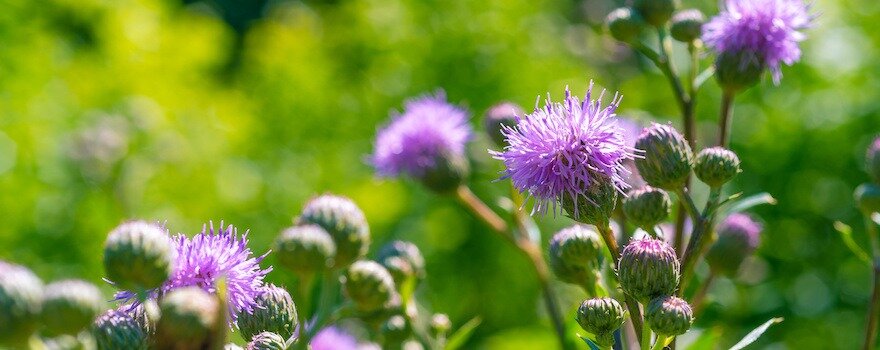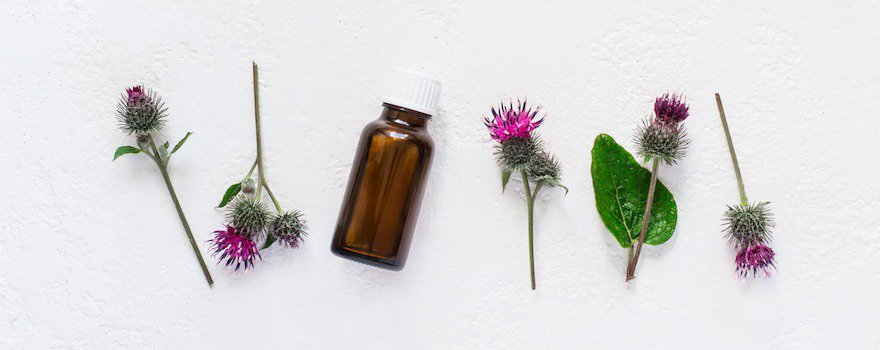What is burdock?
Burdock (Arctium lappa) is a herbaceous plant. Like the dandelion or yarrow, it belongs to the Asteraceae family.
It grows in Asia, North America, and Europe, along paths or in meadows. It can be found up to 1,800 meters in altitude.
Reaching up to 2 meters in height, it produces flower heads covered with hooks. This allows it to cling to animal fur and disperse its seeds in nature.
Purple flowers, similar to those of milk thistle, appear from July to September.
While its leaves are edible, it is mainly the root that is used. Indeed, it concentrates most of the plant’s active compounds, including inulin, a natural fiber rich in prebiotics.
It also contains potassium nitrate, vitamins (B6, B9, C), minerals, and trace elements (manganese, magnesium, phosphorus, calcium, iron, copper).
Thanks to its purifying action, it helps to relieve certain skin diseases such as eczema, psoriasis, or acne. It eliminates accumulated toxins that “suffocate” the skin and promote imperfections.

It also has an anti-inflammatory action that reduces skin inflammation and acne outbreaks.
Finally, it is antibacterial and fights against bacteria responsible for skin diseases, including Cutibacterium acnes. This is why burdock is particularly recommended for acne.
Read also | The best dietary supplements against acne
The roots can be consumed fresh (in a broth, a vegetable stew…) or dried (in an infusion or decoction).
Burdock is also available as dietary supplements in the form of capsules, tablets, powder, mother tincture, or ampoules.
The ideal way is to take it as a cure for 2 to 3 months. It can be combined with other plants with skin properties like wild pansy, dandelion, or nettle.
Burdock extracts are also found in cosmetic care products for oily and acne-prone skin: creams, serums, lotions…
The leaves and roots can also be used in poultice form, directly on the skin and on areas affected by acne.
How does it work to reduce acne?
It detoxifies the body
A great purifier, it stimulates the functions of the emunctory organs, such as the liver and kidneys. The latter are responsible for eliminating accumulated toxins and waste.
Unfortunately, they can sometimes become saturated and unable to perform their roles. At this stage, secondary emunctory organs, such as the skin, take over.
Thus, the elimination of toxins occurs via the skin, which results in the appearance of imperfections or acne.
Burdock is therefore interesting because it supports the main emunctory organs, “cleanses” the blood and the body.
Moreover, it contains potassium nitrate, a mineral compound with diuretic and detoxifying action. It promotes the elimination of waste through the urinary and digestive tracts.
In traditional Chinese medicine, it is indicated for detoxifying the body as noted in this review.
It reduces skin inflammation
The plant has a very interesting anti-inflammatory action in cases of acne. Indeed, this dermatological disease is related to inflammation at the level of the pilosebaceous follicles.
This results in acne outbreaks, papules, pustules, or even nodules.
The root contains lignans such as arctigenin. These compounds have an anti-PAF (Platelet Activating Factor) action, a mediator involved in inflammatory reactions.
In this study, burdock showed beneficial effects on inflammatory acne.

It is antibacterial and anti-biofilm
Finally, the plant exerts an antibacterial action. It fights against bacteria responsible for skin diseases such as Cutibacterium acnes, involved in acne.
It is also anti-biofilm. When the skin microbiota is unbalanced, thin layers called “biofilms” form on the skin’s surface. These isolate bacteria and allow them to grow.
By preventing this process, burdock helps reduce acne and restore healthy skin.
This study shows the plant’s antibacterial and anti-biofilm action.



